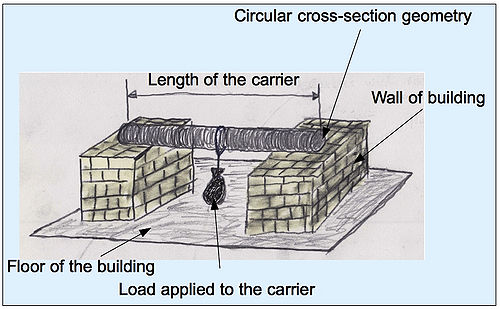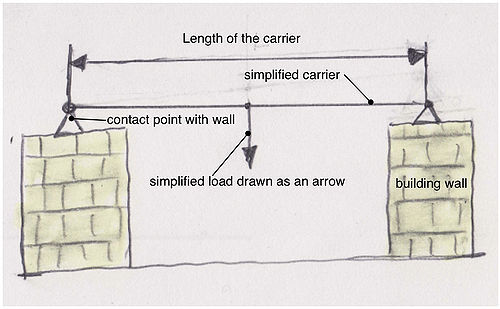Difference between revisions of "What Are Reasonable Spans of Carriers made of Various Materials"
HTP Petros (talk | contribs) (Created page with 'The allowable span which a carrier can have so that it will not collapse depends on three things (for an overwiev see figure 1): <p>+ its cross-section geometry (see examples be...') |
HTP Petros (talk | contribs) |
||
| Line 1: | Line 1: | ||
| − | + | At this part a simple example of a carrier which connects one wall of the house with the other as can be seen in figure 1 is presented. For simplicity the carrier is loaded in its middle with a sandbag. Exactly the same loading would be present if the roof was mounted at this point. | |
| + | |||
| + | [[Image:Uebrsicht Balken named.jpg|thumb|center|500px|Figure 1: An overview of a the most common use of a carrier]] | ||
| + | |||
| + | For reasons of simplifying future calculations and understanding the above figure 1 is remade and represented as in figure 2 | ||
| + | |||
| + | [[Image:Simplified carrier.jpg|thumb|center|500px|Figure 2: A simplified figure of the previous overview to allow easier calculations]] | ||
| + | |||
| + | |||
| + | For the start it is Importatnt to remember that the allowable span which a carrier can have so that it will not collapse depends on three important factors: | ||
<p>+ its cross-section geometry (see examples below in the geometry part)</p> | <p>+ its cross-section geometry (see examples below in the geometry part)</p> | ||
| Line 7: | Line 16: | ||
<p>You can see an overview of a common problem involving a carrier as it would be used for a roofing or for hanging other loads for instance meat.</p> | <p>You can see an overview of a common problem involving a carrier as it would be used for a roofing or for hanging other loads for instance meat.</p> | ||
| − | |||
| − | |||
| − | |||
| − | |||
| − | |||
| − | |||
| − | |||
[[Image:Profiles.jpg|thumb|center|500px|Figure 3: An overview of the most common carrier crossections]] | [[Image:Profiles.jpg|thumb|center|500px|Figure 3: An overview of the most common carrier crossections]] | ||
Revision as of 12:10, 14 January 2010
At this part a simple example of a carrier which connects one wall of the house with the other as can be seen in figure 1 is presented. For simplicity the carrier is loaded in its middle with a sandbag. Exactly the same loading would be present if the roof was mounted at this point.
For reasons of simplifying future calculations and understanding the above figure 1 is remade and represented as in figure 2
For the start it is Importatnt to remember that the allowable span which a carrier can have so that it will not collapse depends on three important factors:
+ its cross-section geometry (see examples below in the geometry part)
+ its material (steel, wood or reinforced concrete)
+ on how you will apply the load on it (is the weight in the middle of the carrier or at one side)
Remember: NEVER use concrete or similar materials like stone without reinforcements of steel or similar for a carrier! The possibility that it will colappse is almost certain!
You can see an overview of a common problem involving a carrier as it would be used for a roofing or for hanging other loads for instance meat.
to be CONTINUED........ Notice: The author accepts no responsibility for the safety of a construction or the correctness of the article
--HTP Petros 15:57, 13 January 2010 (UTC)


